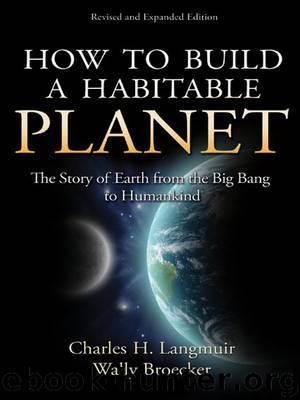How to Build a Habitable Planet by Broecker Wally Langmuir Charles H

Author:Broecker, Wally, Langmuir, Charles H.
Language: eng
Format: epub, mobi
Publisher: Princeton University Press
Published: 2012-02-21T05:00:00+00:00
*R. Chester, Marine Geochemistry (Oxford: Blackwell Science, 2000); and H. Elderfield and A. Schultz, Annu Rev. Earth Planet Sci. 24 (1996):191–224.
**Elderfield and Schultz (1996); hydrothermal fluids have a considerable range in composition. Na and Cl in the hydrothermal fluid are similar to seawater.
In this simple version of events, pure water is removed from the oceans by evaporation, and more mineral-rich river water is added to the oceans in an equal amount. Therefore the water cycle causes more and more chemicals to be added to the ocean, and the mineral content of seawater should steadily increase with time. The ratios of elements would be the same in river water and seawater. It would be a bit like having a tub full of water that you distill to take a shower while standing in the tub. The distilled water you shower with is always clean. At first the tub water is clean, but the dirt and soap would steadily accumulate in it as you took shower after shower, and ultimately the tub water would be so rich in soap and salt that it would become saturated.
The ocean, however, is not overly mineral rich and is not saturated with salt and other minerals. Mineral-saturated water, such as the Great Salt Lake in Utah, has much higher element concentrations than seawater. In fact, there is so little Na in seawater that the entire budget of Na would be added by rivers in only 47 million years. (This was actually one of the early methods that some geologists used to calculate Earth’s age.) Somehow seawater is maintained at steady state far below saturation. Furthermore, ratios of many elements in seawater are vastly different from the river water that supplies the oceans (see Table 12-1). This requires active sinks that are removing elements as fast as they are added, creating a kinetic balance, or steady-state disequilibrium, that has been maintained over limited ranges over Earth’s history. The steady-state composition of seawater below saturation requires a balance between sources and sinks.
The water cycle also does not fractionate radiogenic isotopic ratios. If oceans received all their inputs from the continents, then the radiogenic elements in seawater should have the same radiogenic isotopic ratios as the continental crust that is weathered by the rivers. The most abundant of such elements in seawater is our old friend 87Sr/86Sr. The average 87Sr/86Sr ratio of continental crust is >0.712, while the seawater ratio is much lower, near 0.709. The Sr isotope evidence shows that continents cannot be the only source of material added to the oceans. Seawater requires some other process contributing to both sources and sinks!
One sink is life in the ocean. Organisms with siliceous shells remove Si and those with carbonate shells remove Ca, leading to low Si/K and Ca/K in the remaining water. But then why does seawater have low Mg/K as well? And life does not fractionate radiogenic isotope ratios and cannot explain the Sr isotope data.
The mystery process that balances seawater composition is the ocean ridge hydrothermal circulation.
Download
How to Build a Habitable Planet by Broecker Wally Langmuir Charles H.mobi
This site does not store any files on its server. We only index and link to content provided by other sites. Please contact the content providers to delete copyright contents if any and email us, we'll remove relevant links or contents immediately.
Tools of Titans by Timothy Ferriss(7791)
Turbulence by E. J. Noyes(7689)
Astrophysics for People in a Hurry by Neil DeGrasse Tyson(4997)
Secrets of Antigravity Propulsion: Tesla, UFOs, and Classified Aerospace Technology by Ph.D. Paul A. Laviolette(4972)
Design of Trajectory Optimization Approach for Space Maneuver Vehicle Skip Entry Problems by Runqi Chai & Al Savvaris & Antonios Tsourdos & Senchun Chai(4837)
Room 212 by Kate Stewart(4728)
Pale Blue Dot by Carl Sagan(4610)
The David Icke Guide to the Global Conspiracy (and how to end it) by David Icke(4375)
A Journey Through Divination and Astronomy by Publishing Pottermore(4245)
Apollo 8 by Jeffrey Kluger(3507)
Goodbye Paradise(3439)
Losing the Nobel Prize by Brian Keating(3424)
COSMOS by Carl Sagan(3344)
The Five People You Meet in Heaven by Mitch Albom(3330)
Brief Answers to the Big Questions by Stephen Hawking(3237)
How to Read Water: Clues and Patterns from Puddles to the Sea (Natural Navigation) by Tristan Gooley(3235)
How to Read Nature by Tristan Gooley(3071)
The Order of Time by Carlo Rovelli(3071)
A Brief History of Time by Stephen Hawking(2817)
